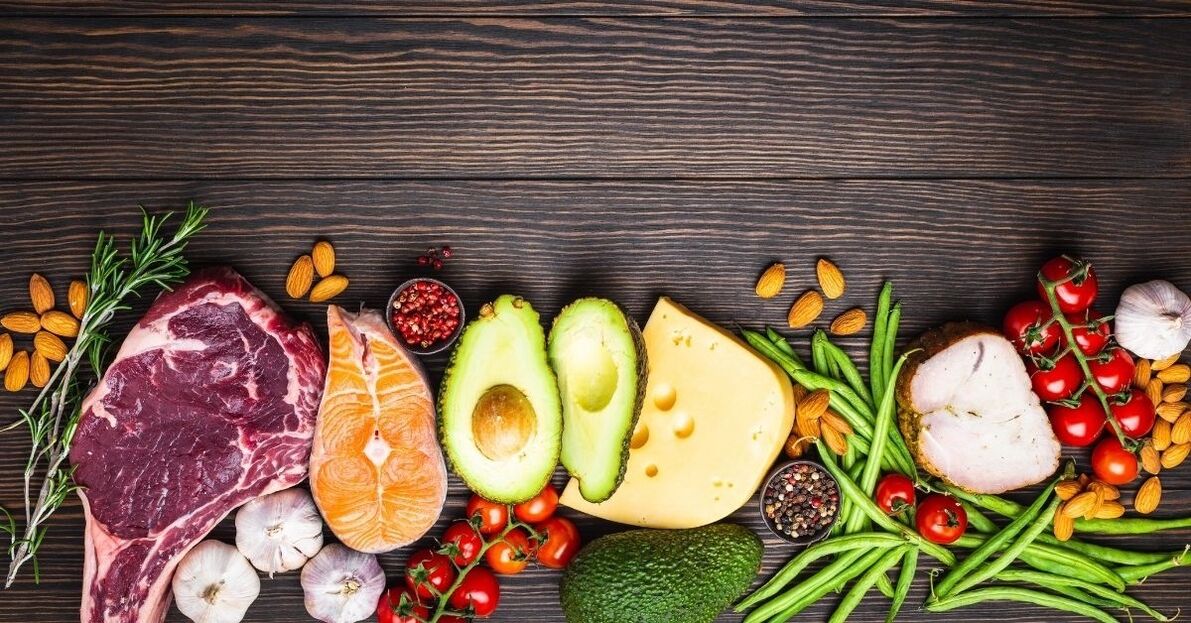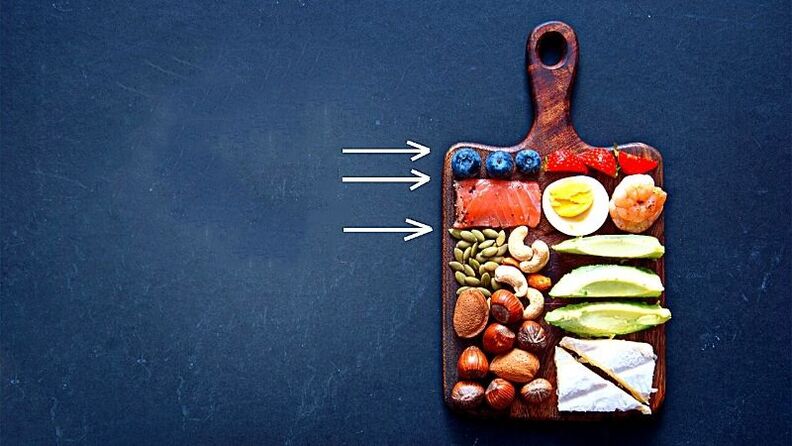
Among the many slimming diets based on reducing the caloric content of the food eaten, there are those that rebuild the body, forcing it to intensively spend its own reserves. The principle of such diets is not a gentle burning, but a forced breakdown of fat cells. The most famous of these is the ketogenic or keto diet.
What is the ketogenic diet?
The ketogenic diet is a nutritional option when the intake of carbohydrates in the body is very limited. The essence of the ketogenic diet is that with this regimen, not glycogen is produced in the liver, but fatty acids. And its decomposition forms ketone bodies, which are a source of reserve energy. This is an ancient mechanism, in fact an emergency one, saves the body in case of lack of carbohydrates. In normal mode, the human body receives a large part of its energy from carbohydrates, they are easier to convert into glucose, which is necessary to provide energy to the brain and body. In an emergency, fat reserves begin to be intensively consumed.
Types of ketogenic diet

There are several types of ketogenic diet. A person chooses his own, based on his personal preferences: what goals he has, what result he wants to achieve, and what opportunities exist for this. Basically, the following types are distinguished:
- Classic. This is the standard option, in which the incoming energy is distributed as follows: fats make up 75%, proteins - 20%, carbohydrates - the remaining 5%. The rejection of carbohydrates should be increased gradually. You can read more about this below.
- Turned. In it, the proportion of fats is 40%, and proteins and carbohydrates make up 30%, respectively. As a rule, this option is observed in the transitional period.
- objective. This option is most often used by athletes or people who intensely play sports. The principle is to consume carbohydrates immediately after training to replenish muscle glycogen stores.
- Cyclic. Alternate ketogenic and carbohydrate diets to build muscle mass and at the same time "dry" it. He usually alternates 4 days of keto and 2 days of carb dieting with a day of fasting.
- The ketogenic diet is rich in protein. Carbohydrates are still scarce, but some of the fat is slowed down by protein. This option is suitable for those who want to save muscle or people who, due to problems with the gastrointestinal tract, have poor fat absorption.
- In the vegetarian version, the source of protein and fat are vegetable products, otherwise it is the same keto diet.
- Some nutritionists use the term "dirty" ketogenic diet. This applies in cases where the fats and proteins come from fast foods and other unhealthy foods. But it can not be called a complete diet.
Why you shouldn't count calories
All low-carb diets have the effect of automatically regulating your appetite. When carbohydrates are not supplied to the body, the level of glucose (or ketones) in the blood remains stable and decreases only when it is necessary to replenish the body's energy supply. As a result, the body itself adapts to the conditions created for it. Subject to the requirements of the ketogenic diet in terms of nutrient ratios, the required caloric content will add up on its own.
Important. If the goal of the ketogenic diet is to gain muscle mass, then calorie content still needs to be taken into account.
Principles of the keto diet
The fundamental principle of the ketogenic diet is not to relax. The state in which the body uses ketones for energy cannot be maintained in the event of a breakdown. If you eat more carbohydrates, the body will respond immediately and come out of ketosis. Everything will have to start over. If you're not ready to adhere to such a radical diet, you shouldn't even start.
what is ketosis
Ketosis is a state in which the body uses ketone bodies instead of normal glucose as an energy source. You can also find a definition as a metabolic state. The goal of the ketogenic diet is the activation of this body system.
How to get into ketosis
To achieve the metabolic state of the body, certain rules must be observed. The body must have time to adapt, so everything must be gradual, without sudden changes in the diet.
- Change the total amount of carbohydrates consumed per day. Their number should tend to 40-50 grams. Next, you need to reduce it to 20 grams. Carbohydrates are consumed in the morning.
- Drinking clean water, at the rate of 3 liters per day or more, depends on the person's body weight.
- Meals should be 5 times a day, with a break of 3-4 hours. The last - 3 hours before bedtime.
- Snacks are prohibited. Unplanned food intake raises the level of sugar and insulin in the blood, which nullifies the effort.
- It is advisable to limit salt intake so as not to overload the kidneys.
- During the diet, it is advisable to devote at least 30-40 minutes a day to physical activity, this will help speed up the process of losing weight.
If a person does everything right, entering ketosis will happen in stages, as the body gets used to the ketogenic diet.
signs of ketosis
There are signs that show a successful entry. At a certain point, the body adapts, understands that there will be no more carbohydrate intake, and begins the restructuring process. Its onset can be understood by the presence of clear signs.
Dry mouth
One of the first signs indicating that the process of accelerated metabolism has begun in the body. It is necessary not to forget about the abundant consumption of clean water. If this condition concerns you, then it is worth adding a little salt to the water you drink throughout the day.
frequent urination
It is also a characteristic sign that the body has entered ketogenic mode. The results of the breakdown of ketone bodies (acetates) are excreted from the body with the urine. This is especially true for those just beginning to enter a state of ketosis, as the body adjusts to the new regimen. Again, it is worth remembering the importance of the drinking regimen.
energy boost

One of the positive aspects that indicates the successful restructuring of the body is a clear feeling of a surge of strength. As a rule, it manifests itself after a period of decline and weakness. The fact is that when the level of carbohydrates is reduced, the body does not receive enough glucose and ketones have not yet begun to break down. This leads to a feeling of weakness and lack of strength. When the liver begins to produce fatty acids instead of glycogen, incoming food begins to be fully absorbed, causing a noticeable increase in energy levels.
Decreased appetite and hunger.
This shows that the final stage of input has begun. The body has fully adapted to the incoming diet, there are no sudden spikes in insulin and now the sensation of hunger arises when it is really appropriate. The body's fat reserve is constantly consumed, this allows you to maintain a certain level of energy without feeling hungry. The transition to this state can take from 2-3 days to several weeks, depending on the characteristics of the organism and the usual physical activity.
The appearance of the smell of acetone from the body and from the mouth.

This is also possible with a ketogenic diet. This is due to the removal of the breakdown products of ketone bodies. The human excretory system is not just the rectum and the bladder. Through sweat and lungs, unnecessary elements are also taken out. If you are concerned about acetone or fruity breath or perspiration, you can add some carbohydrates to your diet. But, as a rule, this effect does not last long - up to several days, and then everything returns to normal.
All of the above signs are normal and indicate the beginning of the metabolic regime in the body. If with all this a person feels a strong deterioration in well-being, it is recommended to start over and reduce carbohydrates in the diet more gently.
Possible Side Effects
A ketogenic diet, even with a gentle entry, is quite a serious shock to the body. The human body adapts to any diet. But in some cases, it can take a long time and be accompanied by unpleasant sensations.
keto flu
This is the name of the set of signs that most closely resemble the symptoms of a viral disease. The more carbohydrates there are on the regular menu, the more difficult it will be to switch to a ketogenic diet. The load on the liver, pancreas changes, even the bacteria that inhabit the intestines are forced to process other foods. All these restructuring processes can be accompanied by certain signs. The "keto flu" includes:
- Headaches and slight confusion.
- Fatigue and breakdown.
- Drowsiness.
- Nausea and discomfort in the intestines.
To alleviate these symptoms, it is recommended to drink as much water as possible, you may need to take additional micronutrients. As a general rule, this condition lasts 5 to 10 days and gradually disappears.
leg cramps

Seizures are most often associated with active urination and leaching of electrolytes from the body. To avoid such a side effect, it is recommended to start taking additional magnesium and potassium immediately from the start of the ketogenic diet. It is advisable to use prolonged-release supplements, they will better help to cope with such an unpleasant condition. In the case of very severe and painful cramps, you can slightly increase the amount of carbohydrates in the diet, but this seriously slows down the achievement of the desired result.
ketoacidosis
If ketosis is a state in which a person enters the body on purpose with the help of a diet, then ketoacidosis is a dangerous complication. This condition occurs when ketones cannot enter the cell to provide energy. In the vast majority of cases, this is due to the level of insulin in the blood. Ketoacidosis is extremely rare in people who do not have diabetes. On the other hand, the debut of the disease can occur at any time, so there are certain signs that you should pay attention to.
- Nausea and vomiting.
- Severe pain in the abdomen.
- Dehydration.
- Drowsiness.
- Low blood pressure and high pulse.
If these symptoms appear, you should immediately contact a medical facility. Doctors should definitely tell you that you are following a carbohydrate-free diet. This will help to quickly diagnose and take a blood test for certain indicators: glucose, ketones and triglycerides.
Tachycardia

This may also be due to a decrease in the amount of fluid in the body. The heart needs more effort to pump thick blood. You may feel like you are beating hard or beating too often. The drinking regimen and mineral intake will solve this problem in a couple of days. If nothing is done, the symptoms may persist for 10-14 days. In a person without heart disease, this should not cause concern.
Dehydration
A dangerous and unpleasant side effect that can occur if the drinking regimen is not followed. At least three liters of clean water per day, and for a person of large build, above average weight, this figure should be higher. To correctly calculate your dose, there are recommended parameters: about 40 ml of pure water per kilogram of weight, with a minimum of 3 liters. That is, a person weighing 80 kg needs to consume 3. 2 liters of water per day, 100 kg - 4 liters, and 60 kg or less - 3 liters.
Constipation on the ketogenic diet
Constipation can be related to two factors:
- Dehydration of the body.
- Lack of fiber due to carbohydrate restriction.
In the first case, it is necessary to adjust the amount of water in the direction of increase. The liquid is excreted not only in the urine, a large amount is absorbed in the intestines. This leads to difficulty in peristalsis due to compaction of the content and therefore constipation.
In the second case, constipation occurs because the usual diet has changed. As a general rule, the main amount of fiber comes from carbohydrate foods. In this case, it is necessary to change the diet so that the proportion of carbohydrates remains low, but non-starchy vegetables serve as a source. Eating greens, salads, zucchini or cucumbers will help.
Flaxseed, steamed with boiling water, will not add carbohydrates, but it will calm the stomach and aid digestion.
mineral deficiency
Fast metabolism and dehydration can lead to mineral loss. To restore the balance, it is convenient to include vegetables rich in these substances in the list of products. All types of cabbage, lettuce, spinach and asparagus will help support the body. Appropriate nutritional supplements can also be used, which can be purchased at pharmacies, so that micronutrient deficiencies do not affect health.
Bad breath

Breath that smells like overripe fruit or acetone indicates that the body is in ketosis. Also, such a problem is possible with dehydration or problems with the digestion of large amounts of protein. If this problem does not go away within a week and is a concern despite normal drinking and oral hygiene, it is worth increasing your carbohydrate intake to 50 grams per day. This will slow down your metabolism and delay your weight loss results, but the odor problem won't be much of a concern.
Exacerbation of urolithiasis
This may be the body's reaction to excess protein in the diet. As the consumption of meat, including red meat, increases, the overall acidity of the body increases. As well as increased stress on the kidneys. To reduce these manifestations, it is recommended to reduce the consumption of red meat in favor of white meat and try to eat foods that alkalize the urine. These are, for example, linseed and olive oils, as well as legumes.
Raise the level of bad cholesterol in the blood.
This is a rather rare effect, which, however, can worry a person. The increase in bad cholesterol levels leads to the consumption of saturated fats, such as fatty meats, lard, butter. It is worth replacing them with unsaturated options: olive and flaxseed oils, nuts, fatty fish. With such a diet, the total cholesterol level can be quite high, but this is good cholesterol, which is necessary for health, maintaining the elasticity of blood vessels and muscles, hormone levels and metabolism.
There is a simple way to determine approximately which product category a fat belongs to: if it remains solid at room temperature, it is saturated, it is better not to use it.
Who is not on the ketogenic diet?
Like any nutrient cut, the ketogenic diet has its own specifics and limitations. Most of them are related to health problems. Among the absolute contraindications:
- Fat malabsorption. Pancreatitis, liver failure - with such diseases, the ketogenic diet will cause serious harm to the body.
- Renal insufficiency. A large load on the kidneys due to protein diet will lead to difficulties in the work of these organs.
- Pregnancy or lactation. The female body during this period works to the limit, you can not add additional stress to it, the consequences can be unpredictable.
In other cases of any health problems, before starting such a strict diet, it is best to consult a doctor to determine if such a diet is right for you.
keto diet for diabetes
On the other hand, it is worth mentioning the possibility of following a ketogenic diet in patients with diabetes. If a person with type 1 diabetes decides to start a ketogenic diet, it must be strictly controlled. The doctor must give permission based on her medical knowledge and experience. Although in general the low intake of carbohydrates contributes to a decrease in glycated hemoglobin, one must be aware of possible complications in the form of ketoacidosis or hypoglycemia. In addition, weight loss makes it necessary to review the doses of insulin administered.
As for type II diabetes, the situation is slightly better. There have been studies that examined the effect of the ketogenic diet on cholesterol and glycosylated hemoglobin in the blood. Overall, most patients experienced positive results. In summary, the benefits of the diet for type II diabetes include:
- Alignment of the lipid profile. Good cholesterol replaces bad, performance improves.
- Decreased insulin resistance. You need to take less anti-diabetic medicine.
- Weightloss. One way or another, this was observed in the vast majority of cases.
In the long term, it is not known if this effect will last, but it is very difficult to maintain a ketogenic diet for a long time. But as a periodic download, it is very suitable.
List of Recommended and Prohibited Products
When a person decides that a ketogenic diet is right for them, the question of which foods to choose makes them think. If everything is more or less clear with proteins, then what to get carbohydrates and fats from is not always clear. To facilitate this task, below you can find a list of products divided into categories. They can be consumed alone, or cook various dishes at home.
Featured Products
There are foods that can be consumed almost without restrictions. These include:
- Meat and meat products.
- Chicken, turkey, duck.
- Fish, sea and river.
- egg white
- Green vegetables.
- Olives and olives.
Some products, in addition to protein and fat, contain large amounts of carbohydrates, so they are not prohibited, but the ratio of nutrients must be taken into account in order not to exceed the carbohydrate norm. Below is a table of some permitted products, with an approximate composition per 100 grams.
| Name | squirrels | fats | carbohydrates |
| Peanut | 26 | Four. Five | ten |
| milk 3, 2% | 2. 9 | 3. 2 | 4. 7 |
| chicken, egg | 12. 8 | 11. 6 | 0. 8 |
| Curd 4% | twenty-one | four | 3 |
| Mozzarella cheese | 22 | 22 | 2. 8 |
| sour cream 25% | 2. 6 | 25 | 2. 5 |
| olives | 0. 8 | 10. 7 | 6. 3 |
For an easy calculation, use the calorie calculator. The calculator already has a large database of products, and many prepared meals are also calculated.
Prohibited Products
All foods rich in carbohydrates are prohibited. First of all it is:
- Cereals and flour products.
- Bake, even without sugar.
- Carbonated drinks.
- Pasta.
- Starchy vegetables.
Separately, it is worth noting low-fat dairy products. On a ketogenic diet, fat is more important than protein. And that milk doesn't contain fat, but it does contain a lot of lactose.
fruits on a keto diet
Despite the sweetness, almost all fruits contain a meager amount of carbohydrates, but a lot of water and dietary fiber, which are not counted in the net carbohydrate content. The most suitable fruits for the ketogenic diet menu are shown in the table. Table based on 100 g.
| Name | fats | Total carbohydrates) |
| Avocado | twenty | 6 |
| Lemon | 0. 1 | 3 |
| Raspberry | 0. 5 | 8. 3 |
| Watermelon | 0. 1 | 5. 8 |
| Cantaloupe | 0. 3 | 7. 4 |
Some fruits are strictly prohibited to buy and consume. These include:
- Banana.
- A pineapple.
- Grape.
- Mango.
- Orange.
There are too many sugars in such fruits, and, accordingly, carbohydrates.
keto diet menu for the week
The menu below for the week for women and men is the same. If necessary, it can be adjusted independently according to personal needs. In the ketogenic diet, the menu is built according to certain principles, where the main thing is not the calorie content, but the ratio of nutrients in the diet.
The optimal diet of the ketogenic diet for a week looks like this:
Day 1
- Breakfast - fried eggs.
- Lunch - Schnitzel with cheese.
- Snack - olives or black olives.
- Dinner - pork chop with spinach.
Day 2
- Breakfast is an omelette with eggs and milk.
- Lunch - fish and vegetable salad.
- Snack - hard cheese.
- Dinner - grilled chicken.
Day 3
- Breakfast is cottage cheese.
- Lunch: grilled turkey with arugula and spinach salad.
- Snack - avocado.
- Dinner: Salmon with a side of green beans.
Day 4
- Breakfast - boiled eggs.
- Lunch - white fish cutlets.
- Snack - fruit.
- Dinner - Greek Salad.
Day 5
- Breakfast: drink yogurt and peanuts.
- Lunch - pork steak and tomatoes.
- Snack - cheese.
- Dinner - cottage cheese.
day 6
- Breakfast is an omelette.
- Lunch - fried fatty fish.
- Snack - vegetable salad.
- Dinner - chicken stewed in coconut milk.
day 7
- Breakfast - scrambled eggs with mushrooms.
- Lunch - roast beef.
- Snack - nuts, berries.
- Dinner - fried chicken.
Recipes for the keto diet
Despite the strictness of the ketogenic diet, there are delicious recipes that follow all its principles. They can also be cooked in a cyclical diet, when high and low carbohydrate intakes are alternated.
Appetizing cheesy broccoli casserole

The recipe is suitable for beginners, it suits both keto and regular meals. It is easy to prepare such a saucepan, you need the following ingredients:
- Eggs - 2 pcs.
- Broccoli - 200 gr.
- Hard cheese - 20 gr.
- Onion - 1 pc.
- Cream 10% - 50 ml.
- Butter - 20 gr.
Broccoli, disassembled into inflorescences, boil in boiling water for 15 minutes. While the cabbage is cooking, fry the finely chopped onion in butter until golden brown. Cooked broccoli is added to the onion, lightly fried all together. Then pour 2 beaten eggs into the pan, sprinkle with grated cheese and bake under a closed lid over low heat for 10-15 minutes.
Omelette with bacon, cheese and mushrooms

This recipe will also appeal not only to those who are losing weight from a lack of carbohydrates. To prepare such a dish, you need to purchase the following components:
- Eggs - 2 pcs.
- Hard cheese - 30 gr.
- Bacon or breast - 60 gr.
- Mushrooms - 100 gr.
- Olive oil - 2-3 tablespoons.
First, fry the mushrooms and bacon in olive oil. Then beat the eggs, mix with grated cheese and pour the mixture into the pan. Fry on one side until cooked, turn over, fry on the second.
Cauliflower soup with chicken broth

This homemade diet soup with a delicate texture is ketogenic and also good for the stomach. To prepare it you need:
- Cauliflower - 200 gr.
- Onion - 1 pc.
- Hard cheese - 50 gr.
- Cream with a fat content of 20% - 30 gr.
- Butter - 20 gr.
- chicken broth - 150 gr.
Finely chop the onion and fry in oil. Boil the cauliflower and shred with a blender. Add cabbage, cream, fried onions and grated cheese to broth. Cook, stirring, 10 minutes.
Keto diet doctor reviews.
According to experts, the ketogenic diet is very harsh and has a number of serious contraindications. The essence of the restrictions is to lose weight or unload some organ. And keto, doctors say, overloads the body and puts it in a state of stress. Endocrinologists are categorically against such restrictions without serious medical reasons.
Some doctors believe that a week or two of such restrictions will only benefit, but you can't eat like this all the time. In any case, starting a ketogenic diet should be done under the supervision of a doctor.
conclusion
The ketogenic diet is not for everyone. A person must be healthy, not have problems with the absorption of fats. This is not a magic pill that will help you lose weight and still eat delicious fatty foods. This is a pretty serious blow to the body, actually forcing you into survival mode. Yes, the results are incredible, the excess weight disappears quickly. On average, a woman of normal complexion can lose up to 5kg in 10 days on keto. The question is how a particular organism will react to this. It is also difficult to fix lost weight.
If you still decide on such strict restrictions, then do not forget about medical supervision, drinking regimen and the fact that such a ketogenic diet is not designed for long.













































































